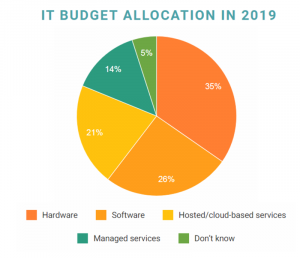2019 is going to be here in a few weeks. While we prepare for the new year, companies focus their attention on a major component of planning for the upcoming year- budgets. How will IT spending change from 2018 to 2019- let’s find out –
- Gartner predicts an upward swing to IT spending in 2019 from $3.74 trillion in 2018 to reach $3.85 trillion in 2019, up 2.8 percent from 2018.
- Worldwide average IT budget allocation will be hardware (35%), software (26%), cloud services (21%), Managed services (26%).
- Comparatively, large enterprises with 5,000+ employees IT budget allocation will be equal for software and hardware (26%), cloud services (24%) and 22% on Managed services.
- Enterprise software is the fastest-growing category, with CxO more likely to spend on it and mobile devices, infrastructure software and business IT services etc. and less on on-premise data centers.

- Spiceworks survey says out of 700 companies interviewed, 89% of them expect an increase in IT budget or expect to remain steady.
- 56% of large enterprises with more than 5000+ employees expect their IT budget to have 20% (average) increase in 2019
- 43% of those large companies predict their IT budget will not increase or decrease in the upcoming year.
- Companies with 1,000 to 4,999 employees are to increase cloud spending by 2 percentage points, while enterprises with 5,000+ employees took their cloud budgets up by 3 percentage points.
- Spending categories at the top of the Cloud list include online backup/recovery (15%), email hosting (11%), online productivity (9%), and web hosting (9%).
- Top Managed IT service spending will be managed hosting (11%), storage/backup (10%), and security (9%).
- Top Software spending in 2019 will be in – Operating Systems (12%), virtualization (10%), productivity (10%), and security software (10%) and industry specific apps and email servers (7%).
- Top factors leading to increased IT budget varied from Upgrade outdated IT infrastructure (64%), increased priority on IT projects (56%), security concerns (56%) to Employee Growth (43%) etc.
